Dappled light refers to that spotted light that typically comes through gaps in a tree canopy. Below is a great example by Claude Monet-notice the spots of light orange amongst the dark purple shadows.

In this post, I cover:
- More Examples of Dappled Light
- Tips for Using Dappled Light in Your Paintings
- Want to Learn More?
- Thanks for Reading!
The shapes created by the dappled light vary based on:
- The position of the sun;
- The height of the tree canopy;
- The shapes of the gaps which light is coming through (which tend to change frequently with the wind); and
- The plane where the light is hitting.
The shapes are also elliptical in nature, meaning they elongate as they get further into the distance.
Below is a photo of what dappled light looks like in life, along with a close-up. This was taken on a clear day, late in the morning. Warm, dappled light was shooting through the gaps in the leaves on the right-hand side.

Another important observation is the soft gradation between light and shadow. You can see this clearly in the close-up below.

(Before diving into this post, make sure to pick up a copy of my free Landscape Painting Starter Kit.)
More Examples of Dappled Light
Below are some more examples, starting with another painting by Claude Monet featuring dense trees and dappled light hitting the rough ground. In this case, Monet appears to have scumbled thick and saturated color over a dark foundation of greens and reds. Also, notice how the dappled light roughly follows the contour in the land.

Ilya Repin’s, Alley in the Park, Kachanivka, is a great example of using dappled light to link two areas: the shadowed path under the tree canopy and the light area in the distance behind the person. Notice how the color used for the dappled light on the path is the same as the color used in the light area. Also notice how the clusters of dappled light get smaller as it moves into the distance, adding a sense of perspective to the painting.

My study below of Mount Barney is another example of using dappled light to link two areas: the shadowed path and the high-key background.

The painting below by Isaac Levitan features dappled light on long, irregular grass. Notice how some tall strands of grass and flowers are picking up light and appear to be intruding on the shadows. This creates an interesting and subtle overlap between light and shadow.
Tip: If you are creating an overlap between light and shadow like Levitan did below, make sure you don’t overdo it. Otherwise, you risk compromising the integrity of your shadows.

Below is an example of dappled light painted with watercolors by John Singer Sargent, appropriately named Corfu. Light and Shadows. An important observation is how Sargent used different colors for the shadows for each plane of the building: light purple/blue for the verticle plane on the right-hand side, warm purple for the left plane, and rich blue for the top plane.

Birthday Teacher (below) features a remarkably complex scene depicting a teacher and students having morning tea, all basked under dappled light.

The painting below is much calmer in comparison to Birthday Teacher above. It depicts two ladies sitting at the table, amongst the buildings and nature. Warm, dappled light is scattered throughout the scene. Observe the warm/cool relationship between the dappled light and shadow.
Tip: A useful exercise when analyzing paintings is to consider where the main light source is coming from (being the sun in this painting). In this case, the sun seems to be overhead to the right, perhaps behind the artist. This is because the light is hitting the right-hand side of the tree. The dappled light which is hitting the wall also appears to be slanting upward to the right, suggesting the position of the sun.

Tips for Using Dappled Light in Your Paintings
Here are some general tips for using dappled light in your paintings:
- If you want to paint realistically, then try picking up the gradual shift between light and dark.
- It can be highly effective to contrast thick paint and warm colors for the dappled light against thin paint and cool colors for the shadows. This creates a striking contrast between light and dark.
- Leave your colors slightly unmixed on your brush when painting dappled light. This will give your strokes an interesting multicolored effect which mimics the appearance of light in nature.
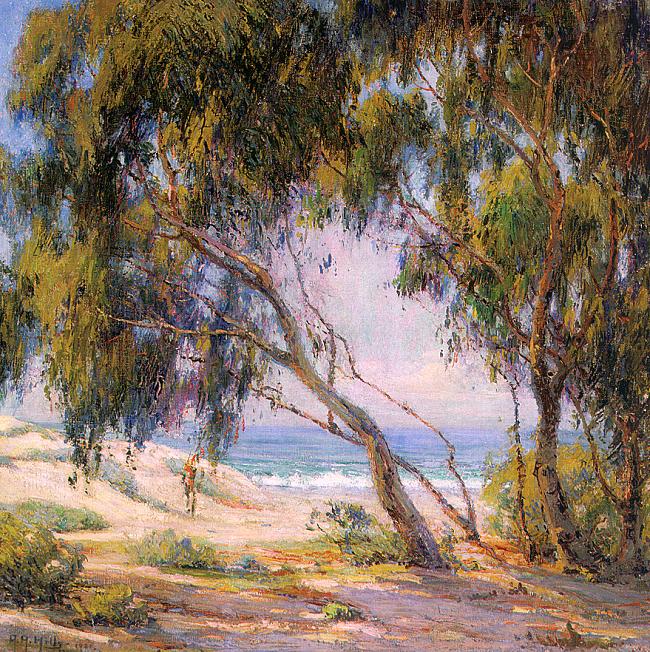
Want to Learn More?
You might be interested in my Painting Academy course. I’ll walk you through the time-tested fundamentals of painting. It’s perfect for absolute beginner to intermediate painters.
Thanks for Reading!
I appreciate you taking the time to read this post and I hope you found it helpful. Feel free to share it with friends.
Happy painting!
Dan Scott

Draw Paint Academy

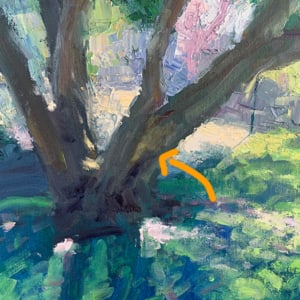
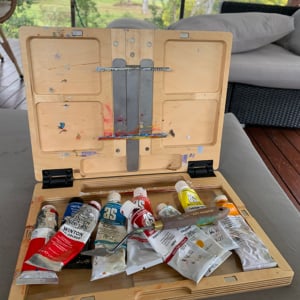
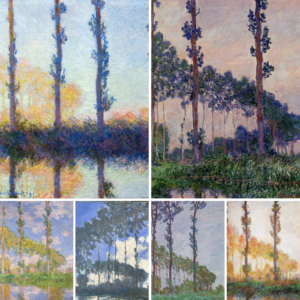


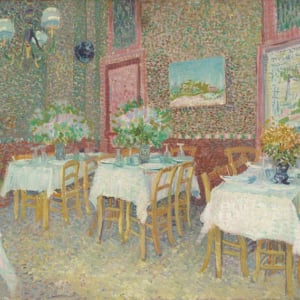
I love your posts, always so much to learn and as always such great examples.
Awesome treatise on the dapple light-I am so very happy to have found your website-truly inspirational not only for the artist but for people to better understand the methods for viewing art.
Thank you and I look forward to joining taking one or more of you courses!
Dan,
As always, another writing that, in seconds of reading, helped me to see the world in a different light.
I love this article and I think the one that will help me the most. I love shadows and the shapes they make. I am always saying to friends “look at the shadows” or “a beautiful day for shadows”. Now I will be looking for the placement of the light source.
This is just the very day I need this. Just about to try it. Thank you. Those paintings are inspirational.
I enjoy your posts. Thank you for sharing your very good insights with examples.
Thank you for such a helpful article!! Im learning to paint shadows these days so I loved reading about it!! I thought I would see a painting of Laurent Parcelier in this article! I would love to hear your opinion for his work!
Thank you for this post. The examples and simple explanation directing my attention to details one at a time is very helpful. You have a gift for teaching.
Thank you Dan. I am impressed by your selection of subjects to write about and the examples you choose. It is most interesting to see the manner in which the various artists treat the subject, Birthday Teacher is a remarkable example and highlights dappling in areas many of us would ignore, particularly the faces.
I am inspired by your posts! Thank you for your tips on how to improve my paintings and to “see” other methods to try.
I have struggled with dappled light for some time. I am going to try to incorporate your suggestions and use the selections as models.
Thanks!
This is very helpful. I am currently working on a painting and the light was something I was battling with, so thank you very very much for this post
Kind regards
Susan
This is very helpful. I am currently working on a painting and dappled light was something I was battling with, so thank you very very much for this post
Kind regards
Susan
Very interesting post! Simple and direct! thanks!
You are an amazing teacher, Dan. I love all your post.
Thank you for inspiring post. It is always great learning new techniques in painting. Thanks again for sharing your knowledge.
Thank you so so much, I’m a new painter and your way of teaching is so wonderful. Your explanations and your examples are right on the mark.
Hey Dan.
Your Hints & Tips, (as I call them,) provide an easy-to-follow/and-understanding guidance, along w/your visuals.
(As artists, I think it’s safe to say we are quite the creative visual creatures. So your tools + visuals go hand in hand.)
Your insights; information; hints/tips, etc., are fantastic. And not just in the way you present, but the topics you’ve chosen to share.
Being self-taught & depending on the web; social media & online sites for info/guidance/getting answers to questions -I sadly must admit, I am disappointed a lot.
One last thing: Some of your selected topics I, myself, would have never thought to study or look into further.
Thank You.
A very appreciative student:
Joanne C. Labelle
Wow–this post is amazing–kind of abstract, yet very realistic.
Hi Dan,
Very helpful post.
Dappled light is something we amateurs don’t think of much until
we see it when we’re out and about, but when we paint we’re to busy trying to get
other things right to think about it.
I will keep it in mind for my next effort and see how it turns out.
Thanks, Dave M????
Really appreciate the simple commentary paired with the paintings and the close up to drive the point home. Makes me want to explore further. Thank you.
A treasure chest of an e mail full of useful and interesting information and with wonderful illustrations . Passing on to a few artist friend who will enjoy too . Thank you Dan
Dappled light – shadows – always been there but now see them through new eyes. Hope
fullly can transpose to my paintings. Can feel them.
Thanks for your continuous inspirational articals.
Kay from SA
I was painting before you were a gleam in your parents eyes, and I am still learning. You have a magical ability to explain, you don’t clutter up the conversation, you simply put into words what it’s all about. I thank you.
Hi Dan,Love your posts they inspire me to keep painting & try out different ideas
Enjoy painting seascapes love the painting Sea View by Anna Hills
Many thanks much appreciated!
Thank you for sharing these wonderful posts. They have helped me expand and improve my paintings. I love seeing different artist’s paintings and learning about their styles and use of color and composition.
Always great content, thankyou.
amazing learning with great examples, loved it! wonderful tools, techniques and teaching.
These are all wonderful examples! Thank you for explaining the different uses of dappled light. I really enjoyed this!
Hi Dan! In the Sargent painting could you explain why he would choose to vary the values of the shadows on each of the three planes of the building? Or maybe direct me as to where to find the answer? Thanks!
You KNOW I love all your posts. I save them and often print them out too!
Your biggest fan (Ok, one of them)… 🙂
Thanks Catherine. Hard to say without seeing what he was actually painting. It could have been something he observed, or he may have used it to create more distinction between the different planes.
Glad you enjoy the posts!
Hallo Dan, mein english ist nicht gut, deshalb übersetze ich die Texte mit Google. Mittlerweile ist die automatische Übersetzung schon recht gut und Sinngemäß. Vielen Dank für die informativen Beiträge. Habe viel gelernt und alle bisherigen Beiträge in Deutsch gespeichert.
Hello Dan, my english is not good, so I translate the lyrics with google. Meanwhile, the automatic translation is quite good and meaningful. Thank you for the informative contributions. Have learned a lot and saved all previous posts in German.
Excellent teacher
Excellent topic
Many thanks for sharing your insights
Kind regards
Meeta
Thank you Sir, I love your classes,the tips of painting. The examples are vibrant the typical painting shown as examples are very nice and informative. Simple to understand.
With regards,
Agamanandan T M
Excellent help, really useful article with clear examples here. It is very helpful for exploring this complex topic, great teaching.
Thank you very much sir, for sharing your knowledge and expertise!
Thank you, Dan, for this post. Enlightening. Helpful to watercolorists, too. I’ll share it with an oil-painting friend.
Hi Dan, this was really helpful. I’m currently doing an assignment for uni on dappled light, and the Monet images you used were a great example.
Hi Dan! I am not an artist however I love art! I happened on your site by chance. I was enjoying a relaxing cup of afternoon tea in my sunroom and the room was bathed in dappled light! It was quite calming and magical to watch the light dance around the room! I googled dappled light and loved all the art you discribed. Thanks so much!
Hi Dan,
Once again, you have inspired me to learn from the Masters by giving such great examples of their use of dappled light and explaining their paintings so thoroughly. I really appreciate your teaching methods and the visual examples you provide.